

Image originally published on front page of New York World March 26, 1911
The Triangle Shirtwaist Factory Fire occurred March 25, 1911 in New York City, killing 146 factory workers. The Triangle Waist Company was a manufacturer of women's blouses. It was located on the top three floors of the 10-story Asch Building. Over 600 people worked in the Triangle factory; most of them were young women. The factory's exits were two elevator shafts with two cars each, two narrow stairways, and a fire escape to an enclosed courtyard. One of the stairways was locked in order to prevent theft by employees. The fire began on the eighth floor of the building in a scrap fabric bin. An eighth floor employee was able to notify the tenth floor by telephone, and the majority of the eighth and tenth floor employees escaped. The 300 ninth floor employees did not become aware of the fire until it had almost reached the floor; around 100 made it down the one open stairway before it became impassible. Several escaped via the fire escape before it collapsed due to the heat and the weight of the people on it, sending many to their deaths. The elevator operators ran the elevators until the elevator tracks warped from the heat. Many people, seeing no other escape, jumped to their deaths. The fire raised nationwide awareness of poor working conditions in factories and was a catalyst for unionization efforts.
This segment by CBS News was produced in 2011 to commemorate the 100th anniversary of the fire.
In this video by WNYC, Serphin Maltese, former New York State Senator and president of the Triangle Fire Memorial Association, discusses the fire. His grandmother and two aunts were killed in the fire
In this video by the NFPA, Jim Shannon discusses the NFPA's response to the fire.
In this video by the NFPA, Robert Solomon discusses the conditions that led to the fire and changes in regulation since that time.